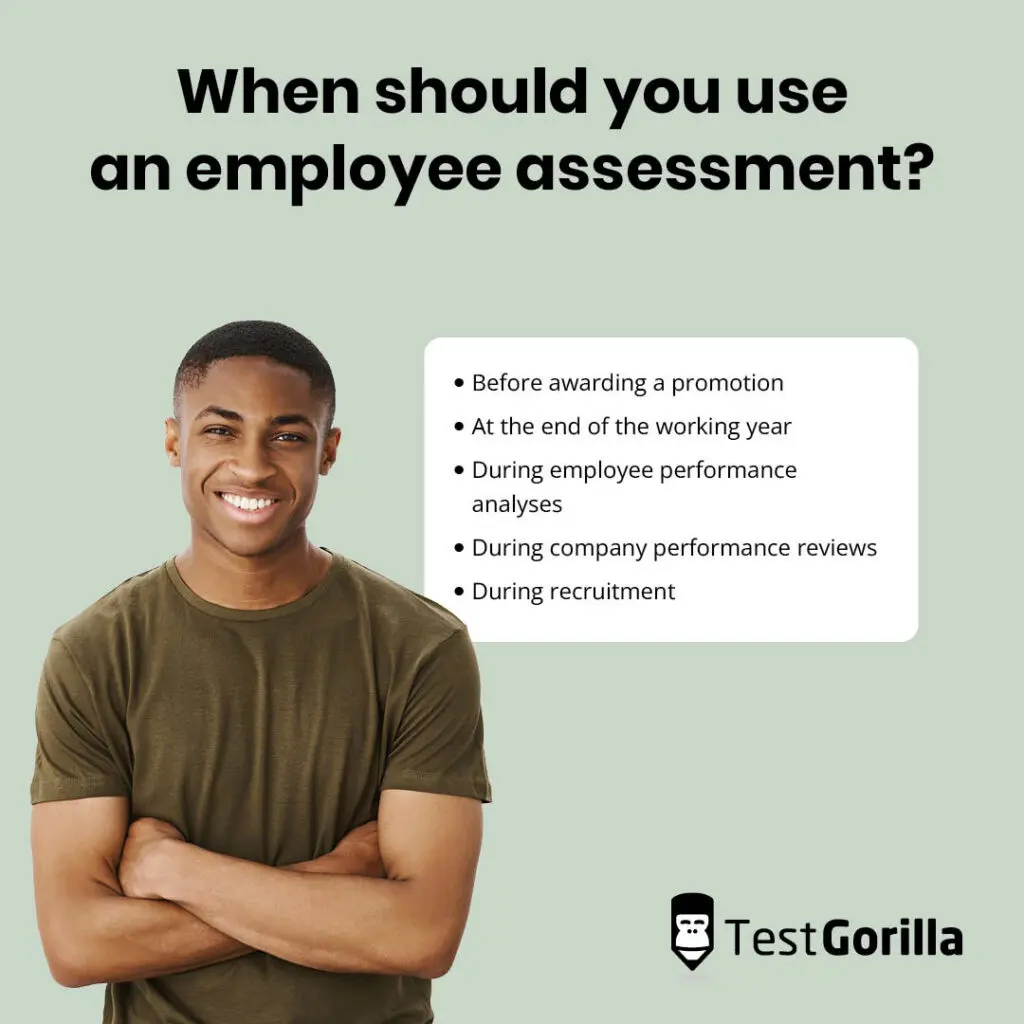Employee skills assessments: How to maximize your existing team's potential
In this article, we define employee skills assessments and explore the various types, as well as the benefits of using them. We also explain when you should use an employee skills assessment to get the best results and discuss how to use these assessments to identify and bridge the skills gaps in your organization.
Employee skills assessments focus on candidates’ current abilities, not what’s written in their resumes. This enables you to evaluate competency among your existing employees for a variety of tasks and assess if they have the right personality to succeed at the job.
Table of contents
What is an employee skills assessment?
An employee skills assessment is a test or a series of tests that companies use to check employees’ capabilities relevant to a particular post. In simpler terms, it is a tool used to measure how effectively a candidate can handle a particular position. This can be useful for internal recruitment and for identifying specific skills gaps within your company.
Identifying the best candidate for a position can be challenging, but an employee skills assessment will help remove the difficulties and reduce the chances of mis-hiring.
The primary function of these skills assessments is to point hiring managers in the direction of the most highly skilled candidates. Employee assessments do this by evaluating candidates against various criteria.
An employee assessment can be done either online or physically. However, most employee skills assessment platforms offer online tests because they are easier and quicker to set up and operate.
When setting up an employee skills assessment, you can group various tests and administer them as a single skills testing package to your candidates. In doing so, you can measure candidates on all the essential skills required for the position.
What are the benefits of assessing your employees’ skills?
There are many benefits to assessing employees’ skills that go beyond simply understanding individual competencies and strengths.
Continuously assessing the skills of your workforce enables you to:
1. Plan your learning and development initiatives for the future
A company grows only if its employees grow. Learning and development (L&D) is an essential part of helping your employees achieve their full potential and productivity.
With the help of specific skills assessments you can better plan out the future growth of your employees by developing learning & development initiatives that are relevant to them.
This way, they can contribute more to the growth of the company and stay up-to-date with the newest innovations in the field.
2. Know the capabilities of your workforce
It’s crucial to understand the capabilities of your employees, because it lets you know what you can and cannot achieve at present, and also helps you make informed decisions on employee workload that’s aligned with teams’ capacities.
This will also allow you to take in as much work as your employees can handle (skill-wise) and will also help you design a recruitment plan that helps you close gaps.
3. Close specific skill gaps
The potential to close skill gaps is probably the most important benefit of assessing your employees’ skills.
Skill gaps are difficult to close at an organizational level, but, according to the Society for Human Resource Management (SHRM), with the right strategic approach, it’s a challenge that organizations can successfully address.
Leading a business means you want to achieve specific business goals within a timeline you define. For you to do that, you need to have certain skills in your workforce so you can deliver your products/services to your clients.
Employee skill assessment allows you to:
Plan recruitment efforts for crucial skills your workforce is currently lacking
Upskill your workforce by addressing specific skills gaps
Evaluate the progress you’re making towards closing skills gaps
When you understand the gap between the current and the desired state, you can act on it.
With that in mind, let’s see how to actually assess employee skills and competencies.
How to assess employees’ skills and competencies
Evaluating the skills of your employees is an important step towards making sure your organization is future-proof and can adapt to changing market demands.
In this section, we’ll discuss the different ways you can assess the skills of your employees.
1. Give them assessment tests
One of the most effective means to collect data on employees’ skills is to give your employees skills tests.
Tests allow you to get an objective overview of each employee’s strengths and expertise, and, according to research, they’re better competence predictors for success at work than years of experience or specific qualifications.
Here is a list of skills assessment tests you can use to comprehensively evaluate skills, abilities, and personality traits.
Types of employee skills assessments
There are various types of skills assessments that you can give your employees, depending on your company's needs.
1. Soft skills assessments
Soft skills assessments measure non-technical but crucial skills such as communication, time management, and collaboration. For instance, a communication skills test might involve scenarios where candidates demonstrate their ability to convey information clearly and effectively, both verbally and in writing. Similarly, time management assessments can include exercises that test how candidates prioritize and handle multiple tasks under time constraints.
2. Technical, programming, and software skills assessments
These skills assessments are designed to evaluate specialized abilities and knowledge specific to roles or tools. For example, a candidate for a software development position might be tested on their proficiency in programming languages like Python or Java. Similarly, a data analyst's role could include assessments of their ability to use statistical software or perform data manipulation tasks.
3. Leadership skills assessments
Aimed at candidates for managerial or supervisory roles, these tests evaluate abilities like decision-making, team motivation, and conflict resolution. A leadership skills assessment might simulate a challenging team dynamic or a critical decision-making scenario to gauge how a candidate would perform in real-life leadership situations.
4. Cognitive skills assessments
These tests measure a candidate's ability to think critically, solve problems, and process information efficiently. They often include logic puzzles, pattern recognition exercises, and problem-solving scenarios. These cognitive skills assessments are valuable for roles that require high levels of analytical thinking and quick decision-making.
5. Role-specific skills assessments
These are tailored to specific job roles, evaluating the necessary skills and expertise for that position. For instance, a sales role assessment might focus on negotiation and customer relationship management skills, whereas an IT support role assessment could test knowledge of specific hardware and software troubleshooting techniques.
6. Culture add assessment
This type of assessment evaluates how well a candidate aligns with the company's values and culture and their potential to add positively to it. It might include scenario-based questions that reveal how a candidate handles ethical dilemmas or fits into collaborative work environments. It's particularly useful for ensuring a harmonious and productive workplace dynamic.
2. Use self-assessments
The first thing you can do is ask your employees to do a self-assessment. With that, your employees will self-reflect on their skill sets, define the areas in which they feel confident, and any areas in which they’d like to receive support.
To get honest self-evaluations, make sure you explain to your staff that you’ll be using these to identify opportunities to invest in their skills, rather than use self-identified weaknesses as liabilities.
You can also set up mentorship programs where employees who are particularly knowledgeable and experienced in specific areas assist their colleagues and help them grow.
3. Get 360-degree feedback
Feedback from peers and managers can be easily combined with the self-assessment the employees do.
To get a full 360-degree assessment of an employee, besides a self-evaluation, you need to ask for feedback from:
Peers
Managers
Subordinates
This will help you get a detailed, in-depth picture that you can use as a data point when assessing the employee’s skills in the future.
Remember that feedback from co-workers always comes with a degree of subjectivity, so look at general trends and compare opinions.
4. Ask for customers’ feedback
Another way you can assess employees’ skills, if they work with clients and customers directly, is to ask for their feedback via a brief customer satisfaction survey.
This way, you can gather data both on your employees’ skills and on customer satisfaction levels. You can then analyze it to understand what skills your employees use when interacting with your customers and to help them improve in specific areas.
5. Put your employees in business simulations
To assess your employees’ skills, you can put them in business simulations to understand how they would act in specific situations. You can then use this information to help employees improve specific skills, such as their:
Business simulations will vary based on your industry and the specific roles, but are a useful tool when assessing whether your employees have the necessary skills to deal with real-life situations.
Why are employee assessments so important?
Employee assessments are a critical part of recruitment, especially when hiring for a remote position. They can help you find the perfect fit for a particular post by testing candidates with carefully prepared questions.
Additionally, employee competency assessments enable you to see your applicants’ skills in action. Here are the key reasons why employee skills assessments are important:
Employee assessments help you measure your candidates’ skills
They help reduce recruitment bias
They enable you to assess multiple candidates simultaneously
They save time and cost
Employee assessments prevent the risk of mis-hiring for a post
They can also help you understand the capacity of your current workforce
They help you classify candidates according to their level of expertise
Ways to use assessment results to improve performance
There are specific ways in which you can use employee assessment results to improve performance, such as:
1. Workshops
You can plan workshops to improve the skills of your employees. You can either plan and design workshops internally, invite consultants or other companies, or sign up your employees for workshops organized by others.
2. Additional qualifications
A good way to improve the skill sets of your employees is to have them get additional qualifications to complement their current skills and knowledge.
Many universities and world-renowned educational institutions like MIT, Harvard, and NYU offer online courses and degrees.
3. Certifications
Getting your employees certified helps improve their skills at work and lowers the skills gap at your organization.
For example, if your employees are using specific software tools, such as HubSpot or Tableau, you can help them get certified by sponsoring certification programs and allocating a certain number of working hours they can use to get certified.
4. Reskilling and upskilling
Sometimes, you don’t need to go through long qualification and certification processes to improve the performance of your employees.
You can provide access to specific tools, such as online courses and libraries, for your employees to reskill themselves, and you can also provide business opportunities for them to develop their skills in real time.
5. Reducing bias
Skills tests, in particular, provide you with objective metrics on your employees’ skills, and that will reduce bias in the workspace.
You will have quantifiable data that will show you the skill level of each employee, allowing you to compare objectively, and address individual weaknesses to improve the performance of your teams and eliminate bias.
6. Personalized development plans
Assessment results can help managers in your company create a personalized development plan for each team member. That way, managers can co-create plans with employees, so they’re both accountable for them. You can do this in the 1-to-1 meetings managers have with their employees.
Employees will develop skills they want to develop and the managers will receive the benefit of upskilling in the form of improved performance and motivation. It’s a win-win situation for both.
7. Employee engagement
When you aim to help your employees grow by using skills assessments and by following through with the results, your employees will notice. They’ll realize that the company really wants to invest in their growth, which will positively affect employee engagement.
According to Gallup, better employee engagement helps increase productivity and profitability by 18% and 23% and decreases turnover by 18%. So any initiative that helps you improve the engagement of your workforce will directly impact your business performance.
When should you use an employee assessment?
Here are five examples of when it can be useful to give a skills assessment:
1. Before awarding a promotion
You can use an employee competency assessment to check how qualified your current employees are for promotion and if they have the skill set to handle new responsibilities.
2. At the end of the working year
Using an employee skills assessment at the end of the working year helps you gauge the strength of your workforce. You can then use the results of the assessment to plan your organization’s goals for the next working year.
3. During employee performance analyses
An employee competency assessment can help you analyze your employees’ performance by checking how advanced their skills are and how much they have improved.
4. During company performance reviews
While reviewing your company’s overall performance, you can use employee assessments to check how well your employees understand and carry out their roles. Ensuring your workforce is focused will help your organization reach its objectives.
5. During recruitment
The recruitment process can make or break an organization because the candidates you hire are your business’s future. Hence, you must take extra steps to ensure you hire the best for your company.
Incorporating an employee skills assessment in your recruitment process will help you sort through applicants and identify those who would be productive in the open role. Moreover, it will help you eradicate hiring bias from your recruitment, improving diversity and the quality of new hires.
Assess your employees’ skills to help your talent grow
Employee skills assessment is key to understanding the value an employee brings to your workplace. You can achieve that with the help of different tools, such as self-assessments, skills assessment tests, 360-degree evaluations, and more.
By evaluating employees’ knowledge, skills, and attitudes, you can better understand what they are capable of and identify areas where they may need additional training or mentorship. This is essential in planning out your workforce growth strategy and retaining your best talent.
With TestGorilla, you’ll find the process to be simpler, faster, and much more effective. Get started for free today.
Related posts
Hire the best candidates with TestGorilla
Create pre-employment assessments in minutes to screen candidates, save time, and hire the best talent.
Latest posts
The best advice in pre-employment testing, in your inbox.
No spam. Unsubscribe at any time.

Hire the best. No bias. No stress.
Our screening tests identify the best candidates and make your hiring decisions faster, easier, and bias-free.
Free resources
This checklist covers key features you should look for when choosing a skills testing platform
This resource will help you develop an onboarding checklist for new hires.
How to assess your candidates' attention to detail.
Learn how to get human resources certified through HRCI or SHRM.
Learn how you can improve the level of talent at your company.
Learn how CapitalT reduced hiring bias with online skills assessments.
Learn how to make the resume process more efficient and more effective.
Improve your hiring strategy with these 7 critical recruitment metrics.
Learn how Sukhi decreased time spent reviewing resumes by 83%!
Hire more efficiently with these hacks that 99% of recruiters aren't using.
Make a business case for diversity and inclusion initiatives with this data.


















